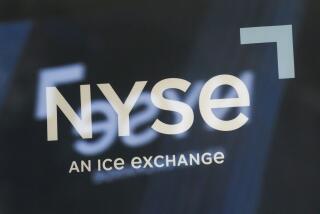Risk Worries Climb in Junk Bond Market
- Share via
Worries about tightening credit, a slowing economy and the financial health of some major debtors have made for a rough two months in the corporate junk bond market, and the turmoil may not end soon.
Junk bonds -- those considered below investment grade -- have been a popular choice for many investors for the last decade because of their high interest rates, or yields. They have generated hefty returns in the last three years as the economy has rebounded and companies’ finances have improved.
But the downgrade of General Motors Corp. and Ford Motor Co. bonds to junk status Thursday by ratings firm Standard & Poor’s was emblematic of Wall Street’s broader concern about some companies’ ability to pay their debts if the economy slows further.
The automakers’ troubles are “a reminder that there’s risk out there” for bond owners, said Margaret Patel, a junk-bond fund manager at Pioneer Investment Management in Boston.
When risk worries rise in the bond market, investors typically demand higher interest rates on the securities to compensate -- and that’s what has happened in recent months.
The average annualized yield on an index of 100 junk bonds tracked by KDP Investment Advisors of Montpelier, Vt., has jumped from 6.35% on Dec. 15 to 7.62% on Thursday, an increase of 1.27 percentage points.
Bond yields go up when their market prices go down. As some investors have sold off their junk holdings this year, the prices of the securities have slumped.
That has left owners of most junk bond mutual funds in the red this year because they haven’t earned enough in interest to offset the loss of principal value. The $9-billion Vanguard High-Yield Corporate bond fund, for example, has lost 1.8% year to date, based on its “total return,” which is interest earnings minus the drop in principal value.
That isn’t a dramatic decline, but it contrasts with the fund’s positive total returns of 8.5% last year and 17.2% in 2003.
To be sure, there hasn’t been a wholesale flight from the junk bond market, which includes securities worth more than a half-trillion dollars in all.
Defaults by companies on bond debt -- meaning when firms fail to pay investors what they’re owed -- have been rare in the last two years. In the first four months of this year, 10 companies defaulted on $2 billion of bonds, according to credit rating firm Moody’s Investors Service. In the same period last year, 14 firms defaulted on $2.5 billion.
But “we probably have seen the low point for defaults,” said Bruce Monrad, co-manager of the Northeast Investors Trust, a Boston-based junk bond fund. As the Federal Reserve makes credit tougher to get, and the economy downshifts, an increasing number of companies probably will encounter problems paying their bills, he said.
That has driven many professional investors to look more closely at their portfolios for companies that might begin to show signs of financial strain later this year or in 2006.
In a nervous market, “You need to get out of higher-risk” bonds, said Mark Unferth, who heads junk-bond investing at Metropolitan West Asset Management in Los Angeles.
The big question is how much higher investors might push junk yields to compensate for the greater risk of things going wrong.
As recently as 2002, when investors weren’t certain that the economy would recover, the average junk bond yield briefly topped 12%. Few market pros believe yields will get back to that level soon, in part because corporate balance sheets overall are in much stronger shape than in 2002, lowering the chances of widespread credit problems.
But if the economic data in the next few months point to a deeper slowdown, the junk market probably will experience more indigestion, analysts say.
Another concern dogging the junk market: “technical” issues, or matters that have little to do with the underlying fundamentals of the companies floating the bonds.
For example, fast-trading hedge funds have become big players in junk bonds in recent years. Because the funds often use borrowed money to make their bets, they face greater risk of loss if their bets go bad -- which, in turn, could lead to heavier selling of junk bonds than the economic backdrop might warrant.
“There’s a big question about the amount of leverage in the system,” Monrad said.
The junk market also must contend with a potential near-term surge in supply, as some owners of GM and Ford bonds sell the securities because they now have the official junk label. Some big investors can only hold investment-grade bonds.
GM and Ford bonds slumped in value Thursday, but how much more selling is ahead is anyone’s guess, analysts say. Also, investors who specialize in junk issues may be more willing to buy the automakers’ bonds as their yields rise.
“We don’t own [GM] but we’re certainly looking at it,” Monrad said.






